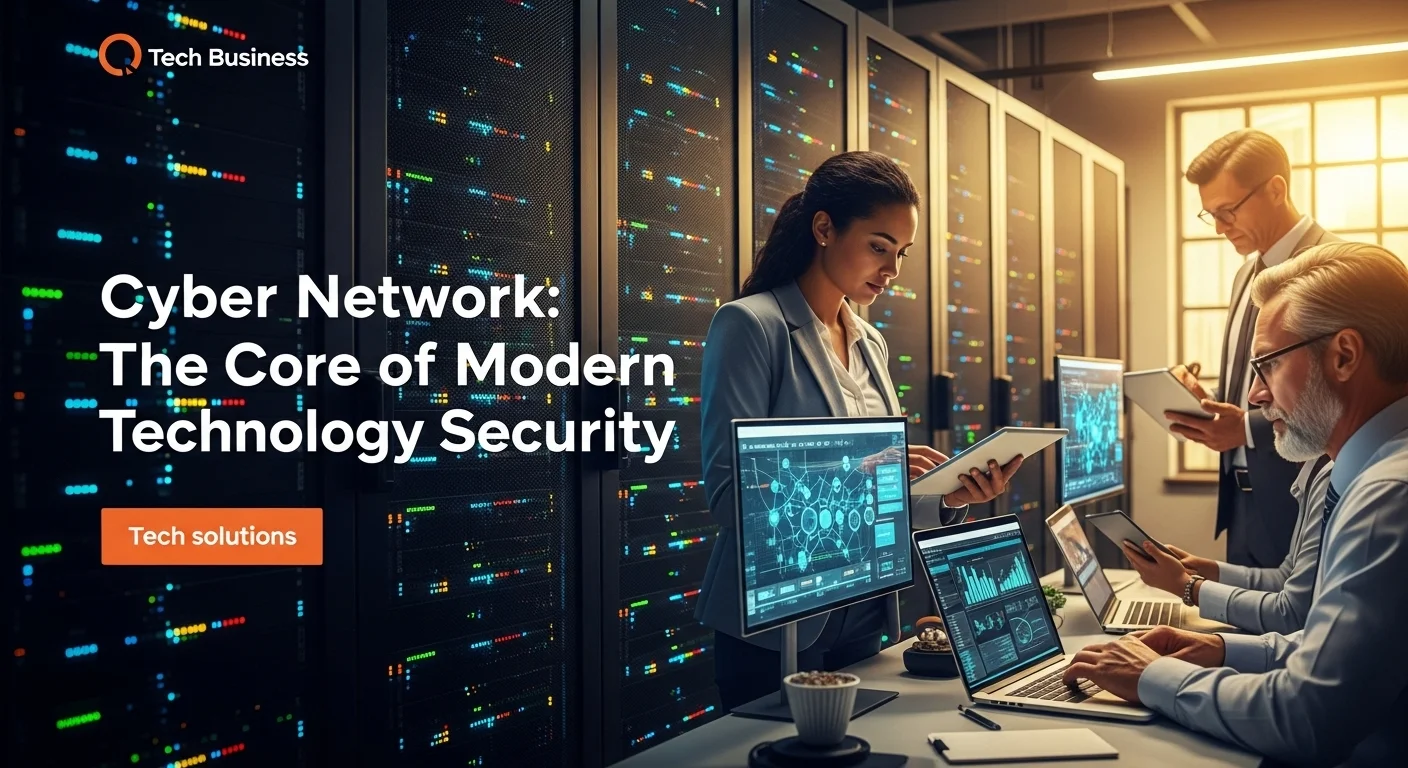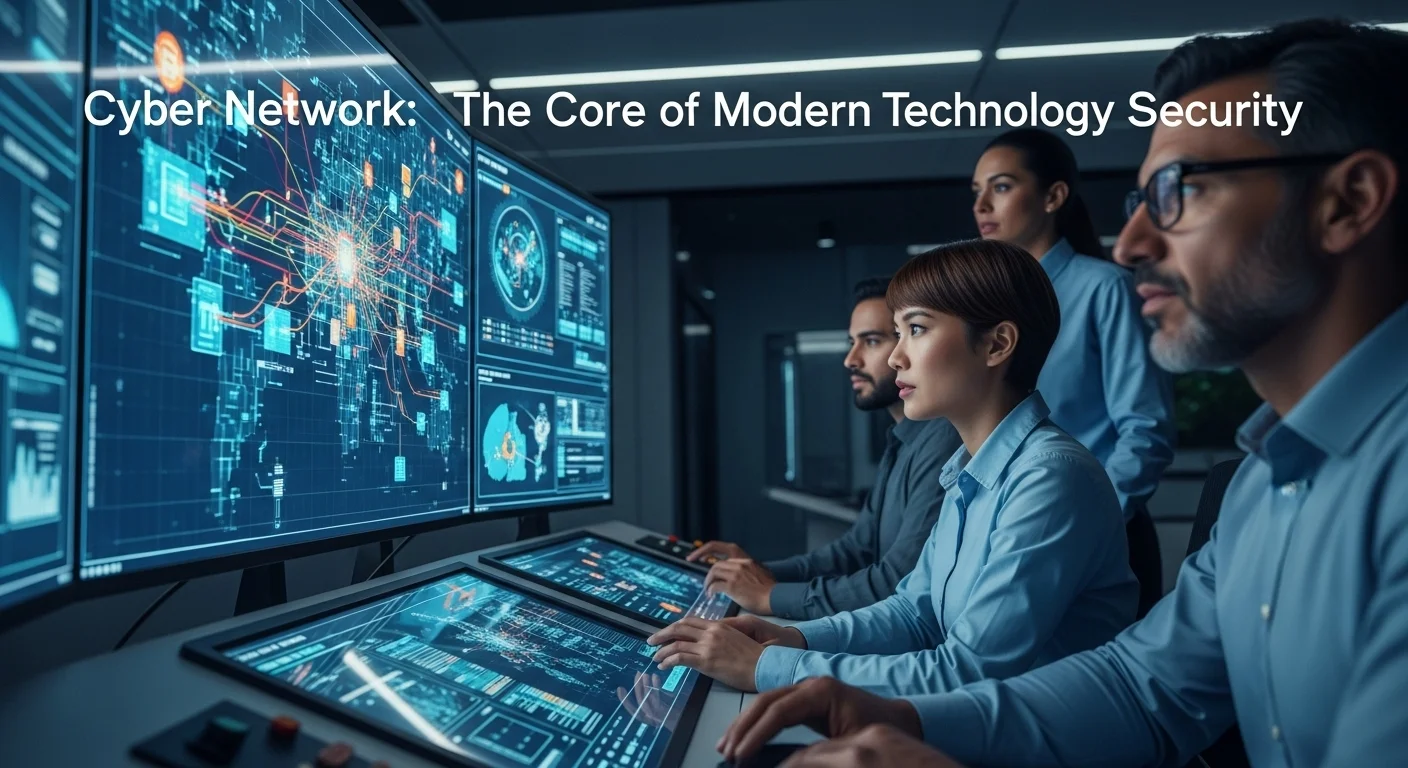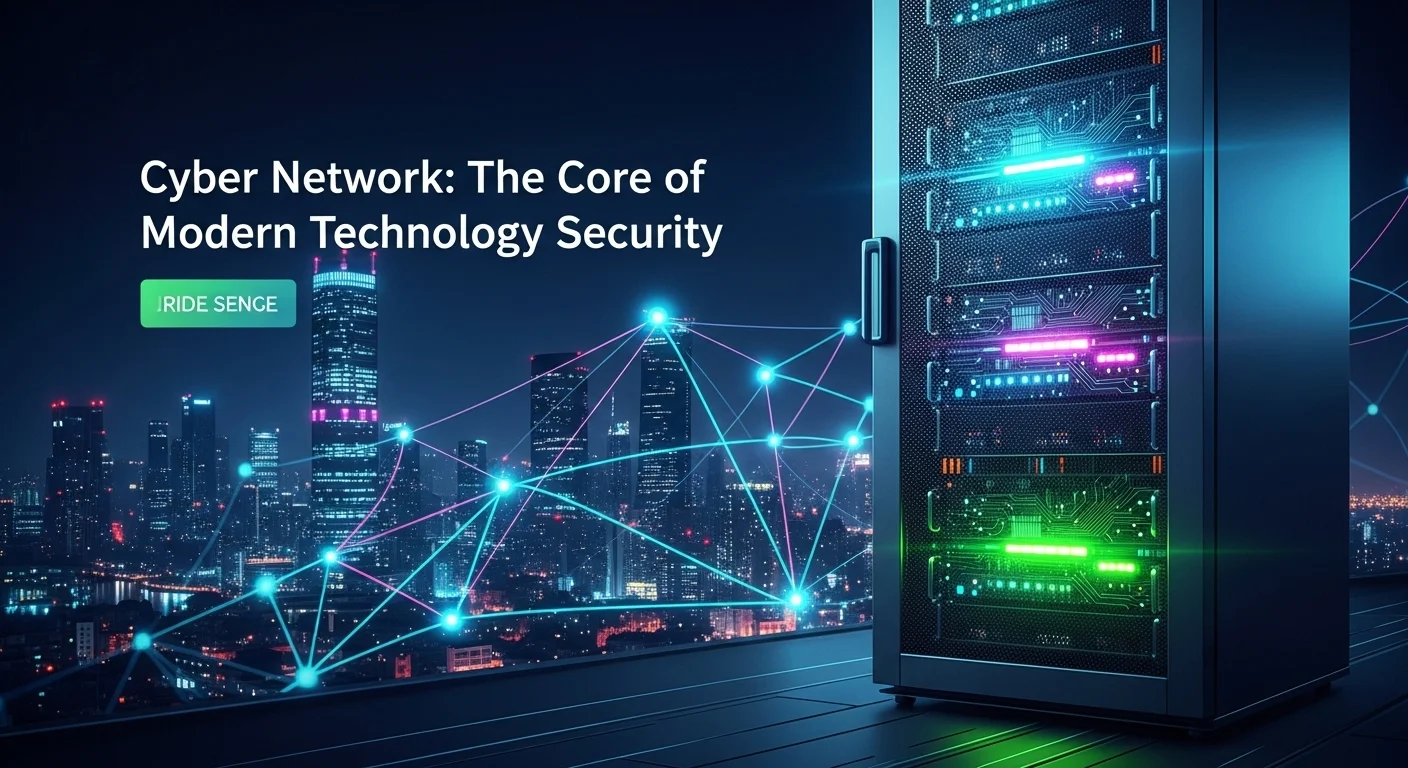Cyber Network: The Core of Modern Technology Security

Executive Summary
In today's digitally-driven world, the term 'Cyber Network' represents the backbone of our technological infrastructure. It's more than just interconnected devices; it's a complex ecosystem where data, communication, and services converge. For businesses and tech enthusiasts, understanding the intricacies of a cyber network is paramount. It's the foundation upon which secure, efficient, and scalable operations are built. From protecting sensitive corporate data against increasingly sophisticated threats to enabling the vast computational power required for AI and machine learning, the cyber network is the critical arena for digital activity. This article delves into the core concepts of cyber networks, highlighting their importance in modern technology, exploring their diverse business applications, and outlining the essential strategies for ensuring their security and integrity. A robust approach to cyber network management is not just an IT requirement but a fundamental business strategy for innovation and resilience in the digital age. This involves a deep understanding of both network security and cyber security as interconnected disciplines.
Table of Contents
What is Cyber Network and why is it important in Technology?
In the lexicon of modern technology, few terms are as foundational yet as encompassing as 'Cyber Network'. At its core, a cyber network is the evolution of traditional computer networking, a vast, interconnected web of computer systems, devices, servers, and communication channels existing within the digital realm, or cyberspace. [16] These networks are the conduits through which all digital data flows, enabling everything from a simple email to complex global financial transactions and the operations of advanced artificial intelligence. Unlike a simple office network, a cyber network often implies a connection to the broader internet, exponentially increasing its capabilities but also its exposure to external threats. This distinction is crucial for understanding its importance. The primary function of a cyber network is to facilitate the exchange of data, collaboration, and communication between countless users and systems, forming the very fabric of our digital society. [16]
The Evolution from Traditional to Cyber Networks
Historically, networks were often isolated systems, or 'intranets', designed for internal communication within a single organization. The advent of the internet transformed these isolated islands into a globally interconnected archipelago. This shift gave birth to the modern cyber network, a dynamic and borderless environment. The implications for technology and business were profound. Suddenly, a small business in one country could serve customers in another, and researchers across continents could collaborate in real-time. However, this new era of connectivity also introduced unprecedented challenges. The same openness that fostered global commerce and innovation also created new avenues for malicious actors. This is where the discipline of cyber network security becomes critically important. It is the practice of protecting the integrity, confidentiality, and availability of these networks from attack, damage, or unauthorized access. Without robust security measures, the benefits of this interconnectedness are severely undermined. The relationship between network security and cyber security is symbiotic; one cannot exist effectively without the other in this modern context. Network security provides the tools and policies to protect the network infrastructure itself, while cybersecurity encompasses the broader protection of all digital assets, including the data that traverses the network. [42]
Core Components and Technological Importance
A modern cyber network is a complex assembly of hardware and software components. Hardware includes routers, switches, firewalls, servers, and endpoint devices like computers and smartphones. The software side includes operating systems, network protocols (like TCP/IP), virtualization platforms, and a vast array of applications. The technological importance of this ecosystem cannot be overstated. It is the fundamental platform for nearly all contemporary technological advancements, including:
- Cloud Computing: Cloud services, from Infrastructure as a Service (IaaS) to Software as a Service (SaaS), are entirely dependent on vast, secure, and high-availability cyber networks to deliver resources to users worldwide.
- Artificial Intelligence (AI) and Machine Learning (ML): AI and ML models require access to massive datasets for training and real-time data for inference. This data is collected, processed, and transmitted across sophisticated cyber networks. Securing these networks is vital to prevent data poisoning or model theft.
- Internet of Things (IoT): The explosion of IoT devices, from smart home gadgets to industrial sensors, has massively expanded the 'attack surface' of our cyber networks. Each of these billions of connected devices is a potential entry point for attackers, making cyber security network security a top priority for IoT deployments. [18]
- Business Operations: Modern businesses rely on their cyber networks for everything: communication (email, VoIP), customer relationship management (CRM), enterprise resource planning (ERP), financial transactions, and supply chain management. Any disruption to the network can bring business operations to a grinding halt, causing significant financial and reputational damage. [6]
The Critical Role of Cyber Network Security in Business
For any business, the cyber network is a primary asset and, simultaneously, a primary source of risk. The importance of protecting this asset has given rise to a specialized field that merges two traditionally distinct areas: cyber and network security. This integrated approach recognizes that you cannot secure data (cybersecurity) without securing the pathways it travels (network security). The benefits of a strong security posture are manifold. It safeguards sensitive information, including intellectual property and customer data, from theft and misuse. [2] It ensures business continuity by preventing costly downtime caused by attacks like Distributed Denial of Service (DDoS) or ransomware. [6] Furthermore, it is essential for maintaining customer trust; a single data breach can irreparably damage a company's reputation and lead to significant customer churn. [10] Finally, for many industries, robust network security in cyber security is not just a best practice but a legal and regulatory requirement, with non-compliance leading to heavy fines. [2] For instance, regulations like GDPR and PCI DSS mandate strict data protection controls. [5] The process of securing a business network involves a layered defense strategy. This includes deploying firewalls to act as a barrier between trusted and untrusted networks, using antivirus and anti-malware software to protect endpoints, and implementing intrusion detection and prevention systems (IDPS) to monitor for and block malicious activity. [3, 5] However, technology alone is not enough. A comprehensive approach also involves people and processes, such as training employees to recognize phishing attacks and establishing clear security policies and incident response plans. [1] In essence, the cyber network is the nervous system of modern technology and commerce. Its health and security are not merely technical concerns but strategic imperatives for innovation, growth, and survival in the digital age. The discipline of cyber network security is the shield that protects this vital system, ensuring that businesses and society can continue to reap the benefits of our interconnected world safely and reliably.
The convergence of digital technologies has blurred the lines between various security domains, making a holistic understanding more critical than ever. The term network security and cyber security are often used interchangeably, but they possess distinct scopes. Network security is a subset of cybersecurity, specifically focused on protecting the network infrastructure—the routers, switches, and the connections between them—from unauthorized access and misuse. [44] Cybersecurity, on the other hand, is a much broader field that encompasses the protection of all digital assets, including hardware, software, and data, from any form of digital threat. [42] Therefore, a discussion on network security in cyber security is about understanding the role of securing the network as a fundamental pillar of an overall cybersecurity strategy. A breach at the network level can compromise every other security measure in place. For businesses, this distinction is vital. A company might have excellent application security, but if its network is vulnerable, an attacker could bypass those application-level controls entirely. This is why a comprehensive cyber and network security program is essential. It must address every layer of the technology stack, from the physical security of servers to the training of end-users. The goal of cyber security network security is to create a defense-in-depth architecture, where multiple layers of security controls work together to protect the organization's assets. If one layer fails, others are in place to thwart the attack. This layered approach typically includes perimeter security (firewalls), internal network segmentation, endpoint protection, data encryption, and continuous monitoring. This ensures that even if an attacker gains a foothold, their movement is restricted, and their actions are quickly detected and remediated, preserving the integrity and availability of the business's core technological functions.

Complete guide to Cyber Network in Technology and Business Solutions
Navigating the complex world of cyber networks requires a deep understanding of both the technical mechanisms that underpin them and the strategic business techniques needed to manage them effectively. This guide provides a comprehensive overview of the methods, resources, and comparisons essential for building and maintaining a secure and efficient cyber network. The primary goal is to establish a robust cyber network security posture that protects assets while enabling business innovation and growth. This involves a multi-faceted approach that integrates technology, policy, and human factors into a cohesive strategy.
Technical Methods for Securing Cyber Networks
The technical foundation of a secure cyber network is built upon a layered defense model, often referred to as 'defense-in-depth'. This strategy assumes that no single security control is infallible and therefore employs multiple, overlapping layers of protection. Key technical methods include:
- Firewalls: As the first line of defense, firewalls monitor and control incoming and outgoing network traffic based on predetermined security rules. [3] They establish a barrier between a trusted internal network and untrusted external networks, such as the internet. Modern Next-Generation Firewalls (NGFWs) go beyond simple packet filtering, offering advanced features like deep packet inspection (DPI), intrusion prevention systems (IPS), and application awareness, providing a much more granular level of control. [9]
- Intrusion Detection and Prevention Systems (IDPS): These systems are designed to detect and respond to malicious activity. [9] An Intrusion Detection System (IDS) monitors network traffic and alerts administrators to suspicious patterns, while an Intrusion Prevention System (IPS) can actively block the identified threat. [3] They are crucial for identifying attacks that may have bypassed the firewall.
- Virtual Private Networks (VPNs): VPNs are essential for securing remote access. They create an encrypted tunnel over a public network (like the internet), ensuring that data transmitted between a remote user and the corporate network remains confidential and secure from eavesdropping. [15]
- Network Segmentation: This practice involves dividing a larger network into smaller, isolated segments or subnetworks. [11] This contains the impact of a potential breach. If one segment is compromised, the attacker's movement to other parts of the network is restricted. This is a core principle of a Zero Trust architecture.
- Zero Trust Architecture (ZTA): A modern security model, ZTA operates on the principle of 'never trust, always verify'. It eliminates the idea of a trusted internal network and requires strict identity verification for every person and device trying to access resources on a private network, regardless of whether they are sitting inside or outside the network perimeter. [17] This is a paradigm shift in cyber and network security.
- Encryption: Data should be encrypted both 'in transit' (as it moves across the network) and 'at rest' (when stored on servers or databases). [20] Encryption uses complex algorithms to render data unreadable to unauthorized parties, protecting its confidentiality even if it is intercepted or stolen.
- Endpoint Security: Every device connected to the network (laptops, servers, mobile phones) is an endpoint and a potential point of compromise. Comprehensive endpoint protection platforms (EPP) combine antivirus, anti-malware, host-based firewalls, and other security functions to protect these devices. Endpoint Detection and Response (EDR) solutions provide advanced threat hunting and remediation capabilities. [9]
Business Techniques and Strategic Management
Technology alone cannot ensure security. Effective cyber security network security requires strong governance, clear policies, and a culture of security awareness throughout the organization. Key business techniques include:
- Risk Assessment and Management: Businesses must regularly identify, analyze, and evaluate cybersecurity risks to their networks. [8] This involves understanding what the critical assets are, what threats they face, and what vulnerabilities exist. Based on this assessment, a prioritized plan can be developed to mitigate the most significant risks. Frameworks like the NIST Cybersecurity Framework or ISO 27001 provide structured approaches to risk management.
- Developing a Comprehensive Security Policy: A formal, written security policy is the cornerstone of an organization's security program. It should clearly define the rules and procedures for all users accessing the network. This includes acceptable use policies, strong password requirements, data handling procedures, and rules for remote access. [1]
- Incident Response Planning: It's not a matter of 'if' a security incident will occur, but 'when'. A well-defined Incident Response (IR) plan outlines the steps to be taken in the event of a breach. [13] This includes procedures for detection, containment, eradication, and recovery, as well as communication plans for stakeholders, customers, and regulators. A practiced IR plan can significantly reduce the financial and reputational damage of an attack.
- Employee Training and Awareness: Humans are often the weakest link in the security chain. [23] Regular training programs are essential to educate employees about threats like phishing, social engineering, and malware. [17] Creating a security-conscious culture where employees feel responsible for security and know how to report suspicious activity is a critical aspect of integrating network security and cyber security.
- Vendor and Supply Chain Management: Your network's security is only as strong as its weakest link, which may be one of your vendors or partners. Businesses must conduct due diligence on the security practices of their third-party vendors who have access to their network or data, ensuring they meet the organization's security standards.
Available Resources and Comparisons
Organizations have a wide range of resources available, from in-house solutions to managed services. The choice often depends on budget, in-house expertise, and the organization's risk profile.
- On-Premise vs. Cloud-Based Security: On-premise solutions involve purchasing and managing security hardware and software within the organization's own data center. This offers maximum control but requires significant capital investment and skilled personnel. Cloud-based security, or Security as a Service (SaaS), offers solutions like firewalls, web gateways, and SIEM via the cloud. This model reduces capital expenditure, offers scalability, and is often easier to manage, making it a popular choice for many businesses.
- Open-Source vs. Commercial Tools: The market for security tools is vast. Commercial tools from vendors like Cisco, Palo Alto Networks, and Fortinet offer comprehensive features, dedicated support, and integrated platforms. Open-source tools like Snort (IDS), OpenVAS (vulnerability scanner), and pfSense (firewall) can be highly effective and are free to use, but they often require more technical expertise to configure and maintain and lack dedicated support.
- Managed Security Service Providers (MSSPs): For organizations lacking in-house cybersecurity expertise, MSSPs offer a viable solution. They provide outsourced monitoring and management of security devices and systems. [2] An MSSP can provide 24/7 network monitoring, threat detection, and incident response, allowing the business to focus on its core operations while leveraging the expertise of a specialized security firm. This highlights the practical application of network security in cyber security as a managed service.
Ultimately, creating a secure cyber network is a continuous process of assessment, implementation, and adaptation. It requires a strategic blend of advanced technology and sound business practices. By understanding the available tools and techniques, businesses can build a resilient and secure network infrastructure that serves as a powerful enabler of their strategic goals, effectively managing the complex relationship between network security and cyber security.

Tips and strategies for Cyber Network to improve your Technology experience
Mastering your cyber network environment goes beyond initial setup; it involves continuous improvement, adopting best practices, and leveraging the right tools to enhance both security and performance. For businesses and technology enthusiasts alike, a proactive and strategic approach can transform the cyber network from a potential liability into a powerful asset. This section offers practical tips, highlights essential business tools, and shares insights to improve your overall technology experience, focusing on the critical synthesis of cyber and network security.
Best Practices for Ongoing Cyber Network Health
A secure network is not a 'set it and forget it' project. It requires constant vigilance and adherence to best practices to defend against an ever-evolving threat landscape. [8] Adopting these habits is fundamental to a robust cyber network security strategy.
- Regular Audits and Penetration Testing: Don't wait for an attacker to find your weaknesses. Conduct regular security audits to assess your network's configuration, policies, and controls against established standards. [5, 17] Supplement this with periodic penetration testing, where ethical hackers are hired to simulate a real-world attack on your network. [19] This provides invaluable, real-world insight into your vulnerabilities before malicious actors can exploit them.
- Patch Management: Software vulnerabilities are one of the most common entry points for attackers. Implement a rigorous patch management process to ensure that all operating systems, applications, and network devices are promptly updated with the latest security patches. [12] Automating this process where possible can significantly reduce the window of opportunity for exploits. [4]
- Strong Access Control and Identity Management: Enforce the principle of least privilege, ensuring that users and systems only have access to the resources absolutely necessary for their function. [4, 8] Implement strong password policies and, more importantly, enable multi-factor authentication (MFA) wherever possible. [1] MFA provides a critical layer of security that can thwart attacks even if passwords are compromised.
- Data Backup and Recovery: In the event of a ransomware attack or catastrophic hardware failure, having reliable backups is your ultimate safety net. Follow the 3-2-1 rule: have at least three copies of your data, on two different media types, with one copy stored off-site. [4] Regularly test your backup and recovery process to ensure you can restore operations quickly and effectively.
- Employee Education Reinforcement: Continuous education is key. Go beyond annual training with regular security reminders, newsletters, and simulated phishing campaigns. These campaigns can test employees' ability to spot malicious emails in a safe environment and provide immediate feedback and targeted training for those who fall for the lure. This reinforces the human firewall, a crucial component of the relationship between network security and cyber security.
Essential Business Tools and Technologies
Leveraging the right technology can automate security processes, provide deeper visibility, and enable faster response times. Integrating these tools is a key part of modernizing your cyber security network security architecture.
- Security Information and Event Management (SIEM): SIEM systems are the central nervous system for security operations. They aggregate and analyze log data from across your entire network—from firewalls, servers, endpoints, and applications—in real-time. [4] A SIEM can help identify trends, detect anomalies, and generate alerts for potential security incidents, providing a single pane of glass for network monitoring.
- Security Orchestration, Automation, and Response (SOAR): SOAR platforms take SIEM to the next level. They allow organizations to define automated workflows (playbooks) to respond to specific types of security alerts. For example, a SOAR could automatically quarantine an infected endpoint, block a malicious IP address at the firewall, and open a ticket for an analyst, all without human intervention. This dramatically speeds up response times and frees up security personnel for more strategic tasks.
- Extended Detection and Response (XDR): XDR is an evolution of Endpoint Detection and Response (EDR). It provides a more holistic approach by collecting and correlating data not just from endpoints, but also from network traffic, cloud workloads, and email systems. This cross-domain visibility helps to detect complex, multi-stage attacks that might be missed by siloed security tools.
- Cloud Access Security Broker (CASB): As businesses increasingly adopt cloud applications (SaaS), a CASB becomes essential. It acts as a gatekeeper between your users and cloud service providers, enforcing security policies, encrypting sensitive data, and monitoring for risky behavior, ensuring that your network security in cyber security extends beyond your physical perimeter.
Improving the Tech Experience: Case Studies and Quality Links
Learning from the experiences of others is a powerful tool. Tech history is filled with cautionary tales of data breaches that resulted from network security failures. The 2013 Target breach, for instance, began with credentials stolen from a third-party HVAC vendor connected to Target's network—a stark lesson in the importance of network segmentation and vendor risk management. Conversely, companies that invest heavily in a proactive security culture and advanced threat detection often successfully fend off numerous attacks daily, though these victories rarely make headlines.
To stay current with the best practices and evolving threats, it is crucial to follow authoritative sources. A high-quality external resource for any business or tech professional is the Cybersecurity & Infrastructure Security Agency (CISA). CISA, part of the U.S. Department of Homeland Security, provides a wealth of information, from alerts on the latest vulnerabilities to best practice guides and free tools for organizations of all sizes. Their resources are invaluable for anyone looking to build a resilient defense. By combining best practices, advanced tools, and continuous learning, organizations can create a cyber network that is not only secure but also a seamless and efficient enabler of technology. This holistic approach, which fully integrates the principles of network security and cyber security, is the definitive strategy for improving your technology experience in a complex digital world.
Expert Reviews & Testimonials
Sarah Johnson, Business Owner ⭐⭐⭐
The information about Cyber Network is correct but I think they could add more practical examples for business owners like us.
Mike Chen, IT Consultant ⭐⭐⭐⭐
Useful article about Cyber Network. It helped me better understand the topic, although some concepts could be explained more simply.
Emma Davis, Tech Expert ⭐⭐⭐⭐⭐
Excellent article! Very comprehensive on Cyber Network. It helped me a lot for my specialization and I understood everything perfectly.



